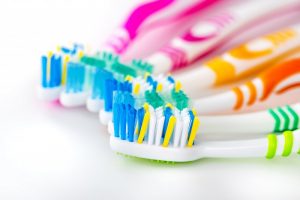 When you’ve got holes in your shoes or socks, it’s obvious that it’s time to make the switch to a new pair. When you’re clothes are out of style or your phone is too slow, you know it’s time for an update on both ends. But do you know when it’s time to swap out your current toothbrush for a new one?
When you’ve got holes in your shoes or socks, it’s obvious that it’s time to make the switch to a new pair. When you’re clothes are out of style or your phone is too slow, you know it’s time for an update on both ends. But do you know when it’s time to swap out your current toothbrush for a new one?
Whether you’ve got a manual toothbrush or an electric version with disposable heads, knowing this makes a huge difference in your oral health. Learn why from a Longmont dentist!
Worn Toothbrushes Aren’t Effective
Many people don’t realize that worn toothbrushes aren’t just unsightly to look at, but they’re also ineffective at removing plaque and preventing dental disease. As the bristles of the brush begin to fray, they aren’t able to reach all the surfaces of teeth as well as they should. Instead of removing plaque and food debris, they simply move plaque around and leave many surfaces unclean.
Furthermore, the areas in between teeth are the most vulnerable to decay and gum disease when cleaned with a significantly used toothbrush. If you don’t floss, that’s additional enamel at risk of plaque exposure. Higher exposure leads to cavities and cavities lead to expensive restorative dentistry later.
When You Should Get a New Toothbrush
Take a good look at the state of your toothbrush right now. If it looks similar to how it did when you first took it out of the box, chances are you’ve got some time to use it longer. However, if the bristles look so frayed, as if a steamroller ran over it, it’s time to get a replacement.
Additionally, toothbrushes should be replaced if you just had a cold or other illness recently. You don’t want bacteria from your previous illness to re-infect you through your toothbrush or spread germs to neighboring brushes if you live with others. Keep in mind that if you have young children, they may need their toothbrushes removed more often since they’re more likely to brush with additional force, which is unnecessary.
Making Your Toothbrush Last
Toothbrushes should last between three and four months, according to the American Dental Association. To keep it clean, always rinse it after brushing and allow it to air dry in an upright position. Avoid keeping your brush inside a closed container as this only allows bacteria to build up. While travel cases may be convenient, you run the risk of introducing new bacteria to your mouth that could cause harm. Instead, purchase a toothbrush every time you go on a trip and dispose of it afterwards.
Want to make sure your family always has a backup toothbrush when they need it? Commit to scheduling routine appointments with a dentist in Longmont and receive a free toothbrush, toothpaste and dental floss with every visit!
About the Author
Dr. Dan Maurer earned his DDS degree from the University of Colorado School of Dental Medicine. One of his favorite aspects of dentistry is getting the chance to help others make a difference in their daily life through their oral health. If you want to learn more tips on toothbrush management or simply learn more about his practice, you can contact him through his website.
